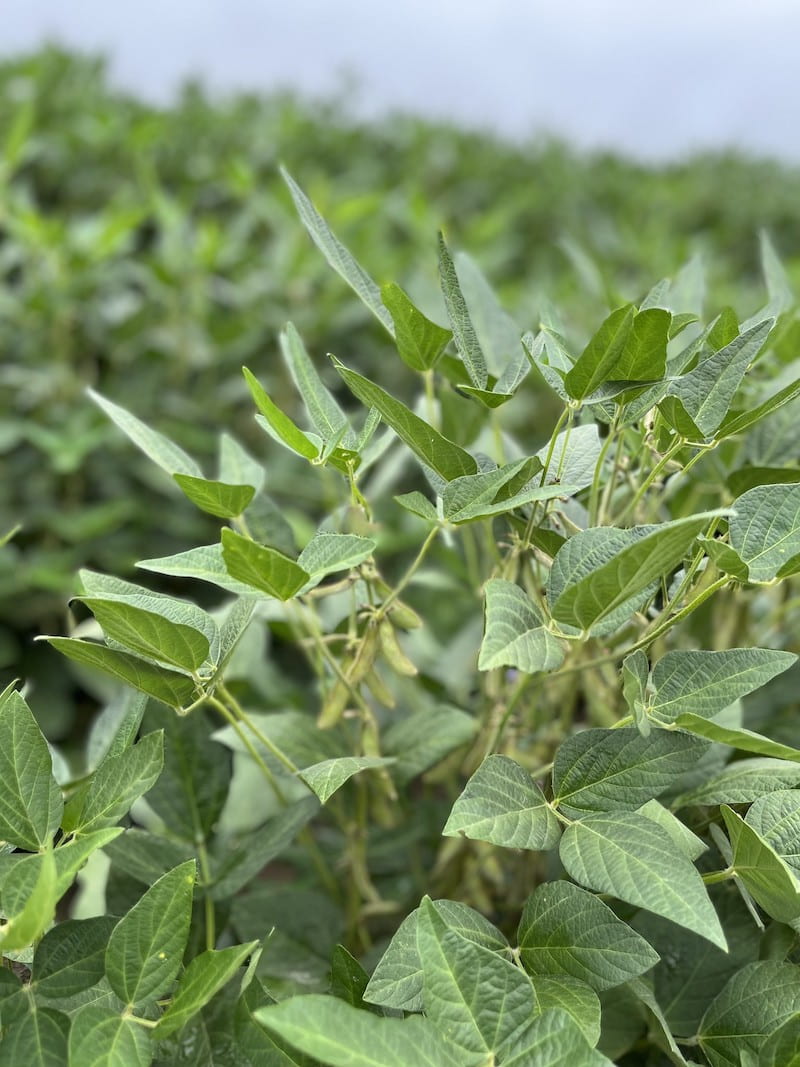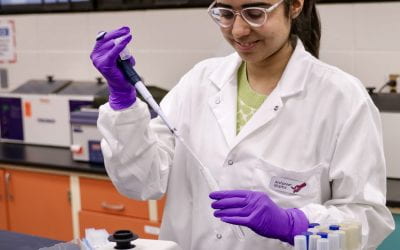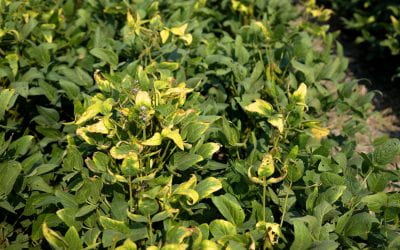YEAREND: Arkansas Soybean Farmers Face Potassium ‘Hidden Hunger,’ Herbicide Resistance Amid Input Cost Increases in 2022
Arkansas harvested 3.15 million acres of soybean in 2022
By John Lovett – Dec. 9, 2022
MEDIA CONTACT
John Lovett
U of A System Division of Agriculture
Arkansas Agricultural Experiment Station
(479) 763-5929 | jlovett@uada.edu
FAYETTEVILLE, Ark. — Despite a bountiful crop of soybeans this year, Jeremy Ross, extension soybean agronomist for the University of Arkansas System Division of Agriculture, said potassium deficiency in Arkansas’ most valuable row crop is becoming more prevalent in the state.
The deficiency is hardly noticeable from visual inspection. An accurate diagnosis requires tissue samples to be analyzed.
“We’re going to be encouraging soybean farmers more next year to send in tissue samples to test potassium levels in soybean plants and take advantage of the free tools available through the Division of Agriculture for potassium recommendations,” Ross said.
While nitrogen fertilizer is often the focal point of most row crop systems, potassium deficiency is the primary limitation affecting soybean profitability, according to Trenton Roberts, professor of crop, soil and environmental sciences for the Division of Agriculture. Soybeans obtain most of their nitrogen through a symbiotic relationship with soil microbes called biological nitrogen fixation.
Two tools developed through the Arkansas Agricultural Experiment Station, the research arm of the Division of Agriculture, include the profit-maximizing potash rate calculator and information on dynamic critical tissue potassium concentration thresholds. The potassium rate estimation tool is available on the Decision Support Software website. Roberts said the critical tissue potassium concentration thresholds are available upon request from a Cooperative Extension Agent. He is working to have the information available online. Roberts said the tools help determine when, where, and how much fertilizer to apply.
Michael Popp, professor of agricultural economics and agribusiness, created the potash rate calculator in collaboration with Roberts and Nathan Slaton, assistant director of the experiment station and professor of crop, soil, and environmental sciences.
2022 soybeans in review
The state harvested about 3.15 million of the 3.18 million acres of soybean planted in 2022, Ross said. It was a slight increase from the prior year when about 3.01 million acres were harvested with a state record average of 52 bushels per acre. The U.S. Department of Agriculture survey projected another state record of 53 bushels per acre this year, but that number could be adjusted once the final numbers are tallied in February. Ross said the average yield was expected to be at least on par with previous years at about 50 bushels per acre. In 2021, the state’s soybean crop was valued at more than $1.94 billion, according to the 2022 Arkansas Agriculture Profile.
While the high heat and drought put a strain on irrigation, the dry conditions suppressed disease pressure and led to a faster harvest, which allowed many farmers more time to prepare their fields for next year’s planting season. Pending the spring weather, that could help them plant soybean crops sooner next year, Ross said.

MEDIA CONTACT
John Lovett
U of A System Division of Agriculture
Arkansas Agricultural Experiment Station
(479) 763-5929 | jlovett@uada.edu
IN REVIEW — Jeremy Ross, extension soybean agronomist, speaks to a group of farmers. (U of A System Division of Ag photo by Fred Miller)
“A bright spot this year was that we got harvested quicker than in the past several years,” Ross said. “A big problem with the drought this summer was that the Mississippi River got too low to ship grain. A lot of the elevators got full, so storage was in high demand.”
Insect pressure from bollworms and corn earworms was evident in many areas of the state, and stink bugs were plentiful, Ross said. The red-banded stink bug reappeared in droves this year, he added, which called for more spraying.
Palmer amaranth “pigweed” and ryegrass are gaining resistance to common herbicides in soybean fields, he added. A mixture of four herbicides is now recommended to control the weeds, but five could be necessary within a few years to combat growing resistance, he said.
Root-knot nematodes also continued to be a serious problem in Arkansas soybean fields. According to data from the Crop Protection Network, economic losses to soybean crops in Arkansas from root-knot nematode increased 180 percent from 2011 to 2021. The network’s data, compiled from farmer input, show that root-knot nematode created a 4 percent yield loss of soybean crops in the state last year –– over 6.6 million bushels valued at over $84.6 million. Soybean cyst nematode damaged about $10.5 million in Arkansas soybeans in 2021.
Fiona Goggin, professor of entomology at the experiment station, continues researching a method to deliver immune-boosting peptides in soybean plants to protect them from root-knot and soybean cyst nematodes. While there are a variety of nematode-resistant cultivars that Arkansas growers can choose from, none can control all strains of soybean cyst nematode and root-knot nematode simultaneously, Goggin said. The nematodes cause similar damage to the plant but are genetically different.
Other challenges in 2022 included input costs on fuel and chemicals. A variety of global economic factors contributed to the high demand and costs, including inflation, the war in Ukraine, and China’s “blue sky” initiative put in place before hosting the 2022 Winter Olympics in February. China, a key supplier of urea, sulfate and phosphate to the global market, curbed fertilizer exports late in 2021 before hosting the winter games.
“Fuel prices were elevated compared to the past few years, and fertilizer costs were almost double,” Ross said. “Herbicide, insecticide, and fungicide prices were also up along with the demand. Trying to get products was a struggle sometimes during the year because the co-ops couldn’t get them.”
A category 4 hurricane that hit Louisiana in late August 2021 led to the largest glyphosate facility in the nation to shut down until mid-October 2021, and there was damage to grain elevators on the Gulf Coast that impacted fertilizer availability in 2022, Ross said.
Ag tech support
Ross said remote aircraft systems, commonly known as “drones,” are still an emerging technology. Still, he has seen more farmers using them to survey their fields and identify areas where irrigation water is not reaching and where spot-spraying pesticides and herbicides may be beneficial.
Farmers also continue to increasingly use soil moisture monitors to better gauge when to apply irrigation. The tools allow more efficient water application and conserve the energy required to run diesel-powered water pumps. Ross said water conservation is on the minds of many farmers because of aquifer depletion.
Soybean genotype research
Larry Purcell, Distinguished Professor of soybean physiology for the Division of Agriculture, continued his work in 2022 to develop varieties that will aid in research to improve protein retention. This year, Purcell also continued a collaboration with plant scientists in Mississippi, Missouri and Arizona to use a groundbreaking method of finding soybean genotypes that can adapt to both dry and wet environments.
To learn more about the Division of Agriculture research, visit the Arkansas Agricultural Experiment Station website: https://aaes.uada.edu. Follow us on Twitter at @ArkAgResearch and Instagram at @ArkAgResearch.
To learn about Extension Programs in Arkansas, contact your local Cooperative Extension Service agent or visit https://uaex.uada.edu/. Follow us on Twitter at @AR_Extension.
To learn more about the Division of Agriculture, visit https://uada.edu/. Follow us on Twitter at @AgInArk.
About the Division of Agriculture
The University of Arkansas System Division of Agriculture’s mission is to strengthen agriculture, communities, and families by connecting trusted research to the adoption of best practices. Through the Agricultural Experiment Station and the Cooperative Extension Service, the Division of Agriculture conducts research and extension work within the nation’s historic land grant education system.
The Division of Agriculture is one of 20 entities within the University of Arkansas System. It has offices in all 75 counties in Arkansas and faculty on five system campuses.
The University of Arkansas System Division of Agriculture offers all its Extension and Research programs and services without regard to race, color, sex, gender identity, sexual orientation, national origin, religion, age, disability, marital or veteran status, genetic information, or any other legally protected status, and is an Affirmative Action/Equal Opportunity Employer.
More Recent News
Food Scientists are Finding Ways to Preserve Food Quality and Ensure Food Safety
Food scientists develop framework to improve food quality and still kill pathogens By John Lovett – Apr. 12, 2024 QUALITY CONTROL — Arshpreet Khattra was the lead author of a study that developed a framework for food...
USDA-Grant Supported FRST Project Releases New Fertilizer Prediction Tool
Fertilizer recommendation tool for farmers could save money and reduce nutrient loss By John Lovett – Apr. 8, 2024 DECISION AID — Farmers have a new fertilizer decision aid available called FRST (Fertilizer...
Nathan McKinney Retires as Assistant Director of Experiment Station
By John Lovett – Mar. 7, 2024 RETIRED — Nathan McKinney retired from the Arkansas Agricultural Experiment Station at the end of March 2024.Nathan McKinney is known across the state of Arkansas as someone who has been...
Food Scientists are Finding Ways to Preserve Food Quality and Ensure Food Safety
Food scientists develop framework to improve food quality and still kill pathogens By John Lovett – Apr. 12, 2024 QUALITY CONTROL — Arshpreet Khattra was the lead author of a study that developed a framework for food...
USDA-Grant Supported FRST Project Releases New Fertilizer Prediction Tool
Fertilizer recommendation tool for farmers could save money and reduce nutrient loss By John Lovett – Apr. 8, 2024 DECISION AID — Farmers have a new fertilizer decision aid available called FRST (Fertilizer...
Nathan McKinney Retires as Assistant Director of Experiment Station
By John Lovett – Mar. 7, 2024 RETIRED — Nathan McKinney retired from the Arkansas Agricultural Experiment Station at the end of March 2024.Nathan McKinney is known across the state of Arkansas as someone who has been...
Value-Added Products Focus of ‘Plan. Produce. Profit!’ Workshop May 6
Value-added products provide options to cut down on food waste By John Lovett – Apr. 3, 2024 VALUE-ADDED — Rusty Rumley, senior staff attorney with the National Agricultural Law Center, will speak on liability in...




